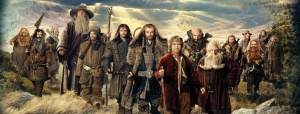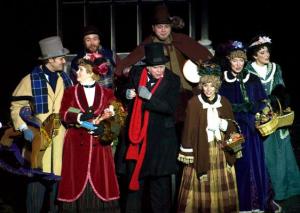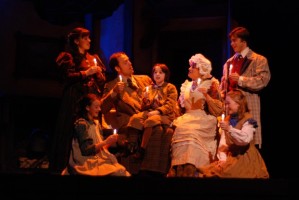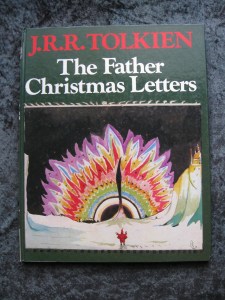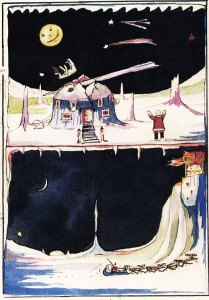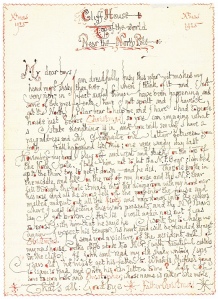A review of The Hobbit: Battle of the Five Armies
from Seven Chapters, shown in Three-D
Part Two
(one last time)
War between elves, dwarves and men is about to begin…
Quick! Read my blog of Part One of this review:http://michaelgcurry.com/2014/12/28/a-late-review-of-the-hobbit-battle-of-the-five-armies/
An army of elves and remaining Laketown humans line the fields in a scene reminiscent of the Battle of Helms Deep in “Two Towers”. When Thorin’s cousin Dain and his dwarves of the northern Iron Hills crest the mountain and march to the Elf/Man army, we share Bilbo’s despair that war cannot be avoided.
Dain, by the way, is marvelously played by comedian Billy Connolly. His presence steals every scene – an incredible feat for such an epic movie! Plus he rides a war pig (Jacksonresisted the One-Ring-level urge to play the Black Sabbath song…) and tells the elves to sod off! What’s not to love?
Just before the three armies come to blows, the orcs attack from underground tunnels. D&Der will thrill at the sight of purple worms bursting through the earth’s crust. Movie fans will have traumatic “Dune” flashbacks. “I will kill him!” MacLachlan! Is … is that Picard? Sting! {SLAP} Oh, sorry … thanks …
The scene of the dwarves holding the line against the oncoming orcs is thrilling – the dwarves and elves unite against a common enemy. If there weren’t just six people in the theater that day, I probably would have cheered!
In Jackson’s non-novel storyline, Legolas and Tauriel travel to Gundabad, an orc stronghold to the north, and find a second orc army coming from the north to form a second attack wave. They arrive to warn the Three Armies just before the second wave hits.
Thorin and company are still held up in Erebor, refusing to help even his cousin. The three armies are being decimated, but still Thorin does nothing. We find Thorin deep in the dwarven compound and watch his internal struggle. He finally comes out of the Dragon Sickness to help his family and friends.
He takes three of his companions to the fortress of Azog “to cut the head off the snake” to paraphrase Gandalf. We watch Thorin and Azog’s final battle (Azog killed Thorin’s grandfather, remember…). Fili and Tauriel resolve their affection with one another – both events done with a sense of finality – especially if you know what was going to happen (I am so glad I read the book before seeing the movie). The inevitable knowledge of the fate of some of the dwarven company made me sad during the movie.
***
(MILD SPOILER) Near the end, the fifth army of the title appears to save the day. No surprise, it is the same “army” who saved the day in three of the past five LOTR movies…).It’s getting to be a bit of a joke … but Beorn’s appearance was cool!(END OF SPOILERS)
***
The aftermath, while not as sad and wistful as “Return of the King” is so, nonetheless. This really is our last visit toJackson’s Middle Earth and we say goodbye to our friends. But seeds are planted foreshadowing the “LOTR” movies. Thranduil and Legolas make an uneasy peace: father telling son to seek out Rangers from the North, one in particular named Strider, whose real identity Legolas must discover himself; Gandalf tells Bilbo to take care of the ring (in the book Bilbo reveals he has a magic ring early on; in this movie series it was always a secret).
The movie series ends as it begins, with Ian Holm as Bilbo writing his memoir “A Hobbit’s Tale, or There and Back Again”
***
People who do not like the genre will probably not like the film. But they didn’t like the LOTR movies either. “Return of the King’s” Oscar sweep won’t happen here. As epic as these Hobbit movies have been, they were made to complete the circle.
In previous blogs I discussed the detractions of this second series of Middle Earth movies: the necessity of making it three films to keep the money machine rolling, etc. But I didn’t think of such things watching this movie. I went in expecting to enjoy it and I did. Obviously, as is always the case with multi-part movies, if you have not seen the first two, I’d recommend renting them and watching them first. You’ll be lost.
The chase scenes that plagued the first two movies are not present here. The battles probably go on longer than necessary (most notably Thorin/Azog), but they are divided out proportionately and I never got the urge to go out to the lobby for a while.
One thing missing in this movie that was prominent in the prior five Jackson/Tolkien epics was the celebration of the small. All through LOTR was the idea that even a little person can make a big difference. My blog of the movie “An Unexpected Party” was rife with the joy of the small. And although Gandalf mentioned that theme in his parting words to Bilbo, it was there in words only. Like “Return of the King”, here we faced a battle that would be sung about for ages. Unlike “Return…”, the very small had no part. It’s the fault of the novel, really. Bilbo got knocked out early on and had to be told how the battle ended. Not quite the case in this movie, but still … one small person (embodied by Bilbo in this series and Frodo and Sam in the first) made no difference in this movie. And not just in the actual battle – his attempts at brokering peace failed; his attempt at breaking Thorin of his Dragon Sickness failed.
“Return of the King’s” climax was not only a battle to end an age, but also featured a pair of small everyday people saving the world. In “Battle of the Five Armies” the climax featured kings battling kings. A grand feast, but I yearned for the small tasty dessert at the end.
I left the theater knowing I enjoyed a complete story, but also knowing it was prequel …
Put another way: the novel The Hobbit is a satisfying and complete read. Although I will probably read LOTR in the near future I was not filled with the desire to read it immediately after putting The Hobbit down.
The movie “The Hobbit”, although completely satisfying, is not satisfyingly complete.
The LOTR movie trilogy was always in the background; always there to compare itself with the Hobbit trilogy. As good as “The Hobbit” trilogy is – and it will stand the test of time as well as the LOTR movies – it will always stand in the shadow of its bigger cinematic brother. Something the novel does not suffer.
Put yet another way: this movie was a great set-up for the LOTR movies – now one can spend an entire weekend watching the six movies instead of “just” an entire day. And as fun and complete and satisfying as it was – it is still also a great set-up for the LOTR movies. A great opening act is still just the opening act …
***
Did 3D help the movie? No. This was my first 3D film since the trend returned with “Avatar” and I was not too impressed. Two scenes were incredibly well-done, I will say: the battle with the Nazgul and Legolas’s fight on the stone bridge. If the whole movie were of that caliber I would go buy a 3D television – do they still sell those?
Otherwise it looked as if I was watching a Viewmaster reel. Things in the front were too blurry and some obvious takes – Thorin holding his sword toward the camera as he walked – took the magic away by reminding me I was in a theater watching a movie in “3D!!! (insert echo)”
And 3D ruins any forced perspective. The magic of suspended disbelief in Peter Jackson’s six movies were based not only on CGI but on forced perspective. Here when a human talks to a dwarf or hobbit you can see how far away they are from each other due to the 3D/Viewmaster perspective. A shame.
***
So go see “Battle of the Five Armies” – enjoy visiting with old friends one last time – just like the advertising campaign says. We probably won’t see another treatment of LOTR or the Hobbit on this scale in our lifetimes. At first I was upset that I had to see this last movie alone. In the prior five films I was surrounded by my family and friends. But as the movie started I realized I was still among some very old and dear friends … and enjoyed it immensely!
Original Material Copyright 2014 Michael Curry


